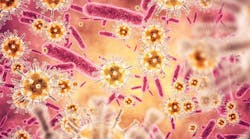Characteristics and treatment of necrotizing periodontal disease (NPD)
What you'll learn in this article
- Key differences between NPD and other periodontal diseases
- Updated classification and terminology of NPD
- Recognizable clinical signs and symptoms of NPD
- Etiological factors and microbial involvement in NPD
- Step-by-step treatment approach for NPD
- When to refer patients for medical or surgical care
Necrotizing periodontal disease (NPD) is a relatively rare and atypical disease, with some important factors distinguishing it from gingivitis and periodontitis. The prevalence of NPD is low in industrialized countries, with an occurrence of 0.19% to 0.5%. Although it can occur at any age, it tends to be more common among young adults.1
In my 13 years as a dental hygienist, I’ve seen only three cases of NPD. However, two of those were during the past year. This led me to wonder if it was coincidental or if the prevalence of NPD is on the rise. Hygienists might need a refresher on how to recognize and treat this uncommon periodontal disease.
Overview and etiology of necrotizing periodontal disease
NPD includes necrotizing gingivitis (NG), necrotizing periodontitis (NP), and necrotizing stomatitis (NS). Evidence indicates that each of these represent different stages of the same disease, with similar etiology, appearance, and treatment recommendations.
Prior to the updated periodontal classification in 2017, these diseases were referred to as necrotizing ulcerative gingivitis (NUG) and necrotizing ulcerative periodontitis (NUP). The terminology “ulcerative” was eliminated because ulceration is secondary to necrosis of the gingiva, which is the hallmark feature of the disease.2 Similarly, the term acute (ANUG or ANUP) was also removed from the nomenclature since no chronic form of this condition exists.3
Patients with NPD typically present with interdental tissue necrosis, spontaneous gingival bleeding, and halitosis. Unlike other periodontal diseases, NPD patients usually experience intense gingival pain, which often leads them to seek treatment. Some patients may have systemic involvement, such as lymphadenopathy, fever, and malaise.
The tissue necrosis characteristic of NPD can destroy the interdental papillae, resulting in the papilla having a “punched out” appearance. This results in a pseudomembrane, or collection of dead tissue cells and debris, which creates a crater-like appearance. In NP, a bony sequestrum can develop—a piece of necrotic bone that has separated from the normal healthy bone that surrounds it. NS is an extension of NG or NP, with necrosis permeating to the deeper tissues, such as the mucosa or lip.3
Although NPD is an infectious condition, predisposing factors, including a compromised host immune response, are critical in the pathogenesis of the disease. The presence of spirochetes and fusiform bacteria was proven to be the bacterial etiology in the late 19th century. More recent advanced microbial testing revealed a diverse array of microorganisms deep within necrotizing lesions, leading to debate as to whether the invasion of bacteria occurs before or after the onset of disease.3
Inflammatory response is a major factor contributing to NPD. The onset of necrotizing gingivitis is characterized histologically by PMN infiltration of the affected tissue, leading to destruction of the soft tissue due to the release of destructive hydrolytic enzymes.3 Predisposing factors can alter the host immune response, typically requiring multiple factors to cause the onset of the disease. These factors include HIV/AIDS, stress, malnutrition, fatigue, inadequate oral hygiene, tobacco and alcohol consumption, and young age.
HIV-infected individuals have a higher risk of developing NPD compared to the systemically healthy population.2 Some evidence suggests that NPD can be an early indication of HIV infection. Therefore, if a patient presents with NPD without other explanatory factors, it may be worthwhile to recommend obtaining bloodwork to rule out HIV infection.4
How to treat NPD
The treatment of NPD requires several stages of careful and regular implementation that focus on reducing patient pain and discomfort, halting the progression and destruction of the disease, restoring form and function of periodontal tissues, and preservation and stability of the periodontium.
The first step of treatment should be to carefully remove the pseudomembrane, which can be accomplished with irrigation and moist gauze. Then, gentle supragingival scaling can be performed using light pressure with ultrasonic and hand instruments. Oral hygiene instructions should include soft toothbrush debridement and chemical plaque control several times a day using 0.12% chlorhexidine gluconate or diluted hydrogen peroxide until the tissues improve.
Patients must be counseled about the importance of getting enough rest, consuming adequate amounts of fluid, avoiding excessive physical exertion and stress, and abstaining from tobacco and alcohol.3 Systemic antimicrobials, such as metronidazole with an antifungal agent to prevent oral candidiasis, may be prescribed.5
A follow-up appointment should be scheduled two days after the initial debridement visit, with subgingival periodontal instrumentation performed as tolerated. Self-care should be reviewed and reinforced as needed. Additionally, control of systemic factors needs to be addressed, such as smoking cessation or referral to a physician.
On the third visit, approximately five days following the initial visit, subgingival instrumentation can be completed. Two months later, the patient should be reevaluated to determine the need for further intervention. A comprehensive clinical assessment must be performed to determine the need for more definitive treatment, such as prophylaxis or scaling and root planing.
Plaque-retentive local factors such as defective restorations and cavitated lesions also need to be addressed. Many patients will require referral to a periodontist for corrective surgical management to reestablish the natural contours of the gingiva that have been destroyed. After disease resolution, the patient can move to the maintenance phase of treatment.3
NS is the most rare and extensive form of NPD, leading to osteonecrosis and sequestration of the surrounding bone. NS is associated with severe immunocompromised conditions, such as AIDS. The same treatment recommendations described here should also be implemented for NS, with the addition of an immediate referral to an oral pathologist, oral surgeon, and physician.5
In conclusion
Although NPD is a relatively uncommon finding in the dental office, it is imperative for hygienists to be able to recognize and appropriately treat these patients. These diseases represent the most destructive and rapidly progressing form of periodontal disease, so immediate treatment is critical. Patients typically respond favorably to treatment, especially when initiated at an early stage.
NPD can be indicative of immune conditions or a warning sign that the patient needs to reduce stress and change lifestyle factors that negatively impact their health. Recognizing and treating NPD is another way that hygienists can help improve our patients’ quality of life and potentially save lives.
References
- Kutsal M, Efe D, Becerik S. Management of necrotizing periodontal diseases at different stages: a case series. NEU Dent J. 2024;6,344-353. doi:10.51122/neudentj.2025.134
- Herrera D, Retamal-Valdes B, Alonso B, Feres M. Acute periodontal lesions (periodontal abscesses and necrotizing periodontal diseases) and endo-periodontal lesions. J Clin Periodontol. 2018;45(Suppl 20):S78–S94. doi:10.1111/jcpe.12941
- Gehrig JS, Shin DE. Foundations of Periodontics for the Dental Hygienist. 6th ed. Jones & Bartlett Learning; 2024.
- Rowland RW. Necrotizing ulcerative gingivitis. Ann Periodontal. 1999;4:65-73. doi:10.1902/annals.1999.4.1.65
- Maddi A, Abel SN, Fine SM, et al. Management of periodontal disease. National Library of Medicine. April 2023. https://www.ncbi.nlm.nih.gov/books/NBK558499/
About the Author

Amy Lemons, MEd, BSDH, RDH
Amy Lemons, MEd, BSDH, RDH, has 13 years of experience and is currently a clinical assistant professor at the OU College of Dentistry in the division of periodontics. She teaches preventive dentistry and periodontal instrumentation to first-year dental students. Most of her work focuses on sharing clinical tips and the latest information in periodontics. Reach her at [email protected].


